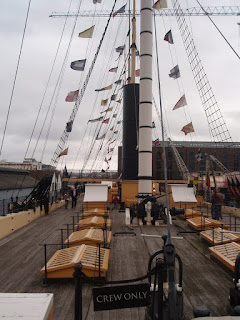This date in 1845 saw the maiden
voyage of SS Great Britain, from Liverpool to New York under
Captain James Hosken, with 45 passengers. This ship is now one of Bristol's biggest tourist attractions.
- The ship was launched on 19 July 1843 at a ceremony with Prince Albert in attendance. The naming ceremony, where a bottle of Champagne is smashed against the hull, went slightly wrong. The local MP's mother, Clarissa Miles, was supposed to perform the honours, but an over enthusiastic tug boat had already begun towing the ship out into the harbour, so the bottle missed and fell into the Water. No doubt this sent the organisers of the event into a panic, as they frantically looked for another bottle. They found one, and Prince Albert himself threw it against the hull.
- The maiden voyage was delayed by over a year as the ship was meant to go to London to be fitted out, but the harbour authorities hadn't modified their facilities to accommodate the world's biggest ship, so SS Great Britain was going nowhere for a year. When she finally got moving, she got stuck in some lock gates and was only saved from severe damage by her skilled captain. They had to try again at higher tide, and remove some coping stones from the sides of the lock to allow the ship to get out.
- She was the longest passenger ship in the world from 1845 to 1854. The ship is 322 ft (98m) long and 50 ft 6 in (15.39m) wide. More than 60,000 rivets were used to build her.
- She was the first Iron steamer to cross the Atlantic. The journey took 14 days. On arrival in New York, a crew member broke his arm badly jumping off the ship, and his injury was such that he couldn't work again. The 19 passengers had a whip round and raised enough money to pension the man off, so we know the first passengers were a) generous and b) rich.
- A year later, things went wrong again. SS Great Britain ran aground, probably because the captain was using out of date charts and mistook the new St John's light for the Calf light on the Isle of Man. She was stuck for almost a year. Getting her afloat again and back to Liverpool actually bankrupted the company which owned her. After sitting in Liverpool for some time, a company called Gibbs, Bright & Co. bought her for £25,000.
- The new owners strengthened the hull and fitted the ship with smaller, lighter engines. The ship made a small number of trips to New York before the company passed her on to a subsidiary company, Antony Gibbs & Sons, which was getting into the transporting of passengers to Australia business. This may have been a temporary measure as there were a lot of people wanting to go because gold had been found there, but the route remained successful for some time. She operated on the England–Australia route for almost 30 years. To make it pay, though, they really had to pack people in - the passenger accommodation was increased from 360 to 730. Eventually, she had such a good reputation as a passenger ship to Australia that she carried the first English Cricket team to tour Australia in 1861.
- The ship had two passenger decks and one for cargo. The principal passenger saloon was 110 ft (34m) long by 48 ft (15m) wide. There were 44 passenger berths and two ladies' boudoirs (private sitting rooms). First class passengers had a choice of thirty courses at meals while in third class they ate salted meats and ship’s biscuits.
- On a typical journey, as well as the passengers and 143 crew, SS Great Britain would also have on board 36 sheep, 140 pigs, 96 goats, 1,114 Chickens, ducks, Geese and Turkeys, and a Cow. The captain was John Gray, a Scot, who had held the post since before the Crimean War - although Captain Gray eventually committed suicide by jumping from one of the rear windows of the ship and was never seen again. The ship's medical log also reports that an eleven year old boy died when his curiosity about the ship's engines got the better of him. Mostly, the doctor had to deal with cases of seasickness, infections, injuries resulting from drunken brawls, and occasionally, childbirth. During the voyage with the cricket team on board, someone was hit in the face by a cricket bat.
- In 1882 Great Britain was converted into a sailing ship to transport bulk coal. Her final commercial voyage was in 1886, to the Falkland Islands. A fire broke out on board which caused so much damage it would not be economically viable to repair her. She was sold to the Falkland Islands Company and used, afloat, as a storage hulk (coal bunker) until 1937, when she was towed to Sparrow Cove, 3.5 miles from Port Stanley, scuttled and abandoned.
- There she stayed until 1970 when Sir Jack Hayward and Sir Paul Getty donated money towards a project to get SS Great Britain afloat and back to Bristol, where she was built. This was achieved and thousands turned out to see her arrive, passing under Brunel's Clifton Suspension Bridge. She arrived back in Bristol on 19 July 1970, exactly 127 years after her launch. She was welcomed back by Prince Philip.
Related Post:
Browse other topics I've covered in this blog - HERE.
Like my Facebook page for news of Topical Ten posts posts on my writing blog, a weekly writing quote and news of upcoming publications |


No comments:
Post a Comment